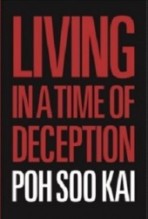 A report of Yeoh Lam Keong’s talk at ‘Muse House’, organized by Function 8 on 6 November 2012 by Chng Suan Tze.
A report of Yeoh Lam Keong’s talk at ‘Muse House’, organized by Function 8 on 6 November 2012 by Chng Suan Tze.
Part 2
Our New Social Compact
Our new compact need to address:
1) Poverty alleviation;
2) Citizen well being; and
3) Equality of opportunity (especially through a more equal education system)
Poverty alleviation:
As mentioned in the opening paragraph, alleviation of poverty in Singapore is not difficult. It can be done within a month and is affordable as it will take only 0.3% of our GDP. It is just a question of the political will of the government.
Citizen well being would require stronger state activism in housing, health care, social security and population control.
Citizen well being:
- Housingused to be Singapore’s greatest social policy achievement. We have achieved higher quality and more affordable public housing than any other country in the world (including Scandinavia). But we have thrown this achievement away and have begun to link public housing prices with private housing prices and now public housing is becoming increasingly unaffordable. HDB seems to think that as long as you can pay your housing using your CPF within 30 years, then housing is affordable. In fact one should spend no more than a quarter of one’s income on housing so that there will be three quarters left for other things like education of one’s children, transport, healthcare, etc…) HDB really needs to think up ways of de-linking private housing prices from public housing prices. The SDP (Singapore Democratic Party) has already come up with a high quality solution on making housing affordable.But there are other solutions – for e.g. not charging the full market price of land and not allowing the resale of such HDB flats until after 10 years (which stops speculation, yet allowing owners to benefit from the long term appreciation of land) or doing away with the sacred cow of home ownership. In Germany for example, only about 50% to 60% of people own homes – for good reasons. While it is good to encourage people to own homes, yet people with low incomes find it difficult to own homes all the time. Consider the four recessions we have had in the last 20 years. People with low income hardly have savings, so it is very difficult to expect them to service their mortgage through the four recessions. There would be a large number of such people who would have lost their flats. So it is good to have large scale low cost rental housing. Hong Kong for example has a very successful 40% of low cost rental housing.
- Healthcare: Singapore and the United States used to be the only two developed countries in the world without universal healthcare. Now with the introduction of Obama care in the US, Singapore now has the dubious honour of being the only country in the developed world without universal health care.Healthcare in Singapore has become increasingly unaffordable, especially with an aging population. Medisave, medishield and medifund are not enough to cope with the increase in medical cost and the shrinking of demographic ratios (7.7 people supports one retired person in 2010 but by 2050 there would be 1.7working adult supporting one retired person). A big crunch is going to come in maintaining family reliance on healthcare.In the 1980s, the government used to pay two thirds of total medical costs and the people pay one third. Now the reverse is true.
- Wages: The huge influx of cheap labour has damaged greatly the earning power of Singapore’s working class. Wages will continue to worsen and generate greater income inequality. Construction workers in Singapore earn $900, those in Hong Kong, $2500. The influx of cheap labour has resulted in firms unwilling to use high value added technology and higher skills. So in terms of productivity of labour, Singapore has a lot to catch up.For example, instead of using 40 to 50 people on site to build a house (as in Singapore) Amsterdam uses 2 persons with skilled operations to do the same job. Such a situation happens not only in the construction industry but in the economy as a whole. So where productivity is concerned we have a lot to catch up. Wage stagnation/depression is certainly not going to improve social well being.
- Population growth – should largely be high skilled immigration and minimal low skilled immigration. It has to be carefully managed to prevent overcrowding leading to increase in social tension.
Equality of opportunity:
The key to citizen well being is also the realization of the Singapore dream – the need to feel that your children are going to do better than yourself; knowing that your children have the same opportunity as your richer counterpart. But as seen above, the playing field is not level. There is the need for stronger state activism to level the playing field.
So what kind of society do we want?
According to Yeoh, the reforms needed are:
- Restrict labour force growth to max of 0.5-1% per annum
- Aim for 2-3% productivity and real wage growth;
- Even higher “catch up” wage and productivity growth for low wage workers
- Target terminal population of closer to 6-7 rather than 8-10+ million by 2050
- Treble WIS payouts and streamline welfare payments, establish effective unemployment protection and pension adequacy reform, especially for low income workers
- Special support for SMEs to adjust to restricted labour supply needed to prevent crowding out by big foreign firms
- Move towards universal healthcare with compulsory national health insurance and the govt covering two thirds of total medical costs
- Restore public housing prices to 2-3 times household incomes and establish a mass public rental market
- Double education expenditure to halve class sizes and the need for tuition and do away with streaming before age of 16
What kind of public expenditure are needed for reforms?
Yeoh’s recommendations are:
- 4-5% of GDP for health care;
- 3-4% for education;
- 1-2% for social security;
- 1-2% for industrial policy
The above adds up to roughly 10-12% of GDP. Currently we are at 17% of the GDP for public expenditure. With the addition of 10% of the GDP, public expenditure will stand at 27-29% which is still one of the the lowest percentage of public expenditure in the developed world and makes our expenditure comparable to Korea and Taiwan
Present Singapore and Possible futures for Singapore:
| Present Singapore | Possible futures for Singapore |
| MNC /global large firm led industrial development | SME/local industrial capability development (an ‘EDB for SMEs’) |
| Rather than the current Manufacturing as a key strategic sector | Selected high value chain capabilities (“Mittlestand” long-term capability development objectives) |
| High, immigration intensive growth | Modest, high quality productivity intensive growth (3-4% long-term growth target 2-3% productivity growth and 0-1% labour force growth) |
| Individual and family reliance | Low immigration, renewed tri-partism (largely high skilled immigration with minimal low skilled immigration) |
| Minimal welfare Market driven | Stronger state activism in housing, healthcare, education, social security, infrastructure (Doubling rate of investment in education/vocational training with strong industry involvementGuided real wage increases in line with productivity Affordable housing, universal healthcare, stronger social security system,) |
| Weak regional governance | Stronger regional governance (Building civic infrastructure) |
| Present Singapore | Possible futures for Singapore |
| MNC /global large firm led industrial development | SME/local industrial capability development (an ‘EDB for SMEs’) |
| Rather than the current Manufacturing as a key strategic sector | Selected high value chain capabilities (“Mittlestand” long-term capability development objectives) |
| High, immigration intensive growth | Modest, high quality productivity intensive growth (3-4% long-term growth target 2-3% productivity growth and 0-1% labour force growth) |
| Individual and family reliance | Low immigration, renewed tri-partism (largely high skilled immigration with minimal low skilled immigration) |
| Minimal welfare Market driven | Stronger state activism in housing, healthcare, education, social security, infrastructure (Doubling rate of investment in education/vocational training with strong industry involvementGuided real wage increases in line with productivity Affordable housing, universal healthcare, stronger social security system,) |
| Weak regional governance | Stronger regional governance (Building civic infrastructure) |
On a more positive note we have huge fiscal resources, excellent infrastructure and info communications, a bilingual workforce, a well educated elite and a resilient civil service. If we play our economic cards right, use our resources intelligently we can insulate our population from looming disasters and still take advantage of the dynamic region (We are in the heart of the Asian centric economy) we are in, to grow and prosper.
Finally it is good that we are having a national conversation but it is hard to have a sensible national conversation if we do not know the trade offs. It is like going shopping without knowing your budget. You would not know what you can buy and what you cannot. If our budget is a secret, if it is classified information then it is hard to plan.
So the storm is imminent. What is the government going to do about it? What can we as responsible citizens do before the full force of the storm is unleashed?




